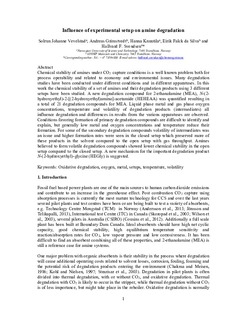| dc.contributor.author | Vevelstad, Solrun Johanne | |
| dc.contributor.author | Grimstvedt, Andreas Magnar | |
| dc.contributor.author | Knuutila, Hanna | |
| dc.contributor.author | Silva, Eirik Falck da | |
| dc.contributor.author | Svendsen, Hallvard Fjøsne | |
| dc.date.accessioned | 2017-10-25T07:15:47Z | |
| dc.date.available | 2017-10-25T07:15:47Z | |
| dc.date.created | 2014-09-09T14:45:23Z | |
| dc.date.issued | 2014 | |
| dc.identifier.citation | International Journal of Greenhouse Gas Control. 2014, 28 156-167. | nb_NO |
| dc.identifier.issn | 1750-5836 | |
| dc.identifier.uri | http://hdl.handle.net/11250/2462000 | |
| dc.description.abstract | Chemical stability of amines under CO2 capture conditions is a well known problem both for process operability and related to economy and environmental issues. Many degradation studies have been conducted under different conditions and in different apparatuses. In this work the chemical stability of a set of amines and their degradation products using 3 different setups have been studied. A new degradation compound for 2-ethanolamine (MEA), N-(2-hydroxyethyl)-2-[(2-hydroxyethyl)amino]-acetamide (HEHEAA) was quantified resulting in a total of 21 degradation compounds for MEA. Liquid phase metal and gas phase oxygen concentrations, temperature and volatility of degradation products (intermediates) all influence degradation and differences in results from the various apparatuses are observed. Conditions favouring formation of primary degradation compounds are difficult to identify and explain, but generally low metal and oxygen concentrations and temperature reduce their formation. For some of the secondary degradation compounds volatility of intermediates was an issue and higher formation rates were seen in the closed setup which preserved more of these products in the solvent compared to the open setup with gas throughput. Amines believed to form volatile degradation compounds showed lower chemical stability in the open setup compared to the closed setup. A new mechanism for the important degradation product N-(2-hydroxyethyl)-glycine (HEGly) is suggested. | nb_NO |
| dc.language.iso | eng | nb_NO |
| dc.publisher | Elsevier | nb_NO |
| dc.title | Influence of experimental setup on amine degradation | nb_NO |
| dc.type | Journal article | nb_NO |
| dc.type | Peer reviewed | nb_NO |
| dc.description.version | submittedVersion | nb_NO |
| dc.source.pagenumber | 156-167 | nb_NO |
| dc.source.volume | 28 | nb_NO |
| dc.source.journal | International Journal of Greenhouse Gas Control | nb_NO |
| dc.identifier.doi | 10.1016/j.ijggc.2014.06.028 | |
| dc.identifier.cristin | 1152987 | |
| dc.relation.project | Norges forskningsråd: 189998 | nb_NO |
| dc.description.localcode | This is the authors' manuscript to the article (preprint). | nb_NO |
| cristin.unitcode | 194,66,30,0 | |
| cristin.unitname | Institutt for kjemisk prosessteknologi | |
| cristin.ispublished | true | |
| cristin.fulltext | preprint | |
| cristin.qualitycode | 2 | |
